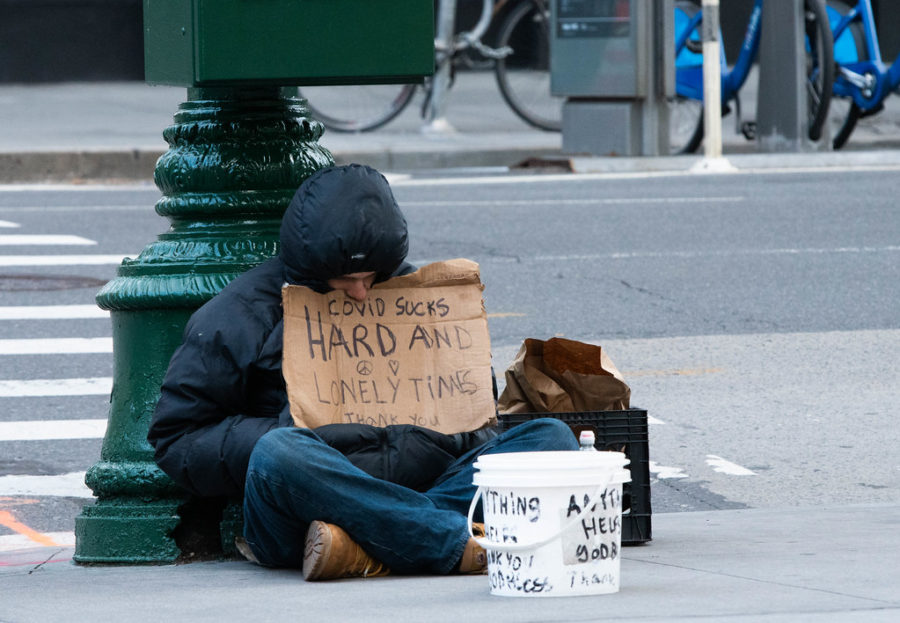Anti-homeless sentiment needs to stop
Homelessness must be destigmatized before it can be effectively solved.
February 3, 2023
Homelessness has been an issue since the 1800s, experiencing dips and swells over the centuries. It seems that now we are in another particularly bad spell. Homelessness across the country is rising, and we have to do something quick. Homelessness can be attributed to a myriad of reasons, such as illness, disability, or addiction, but by far the most prominent factor is the complete lack of affordable housing availability. Without enough housing, a certain portion of the population will always be relegated to homelessness. Housing has been made impossible for many due to the recent intense inflation – housing is getting more and more expensive, and more and more people are unable to afford it.
It is important to note that though more people are unable to afford housing anymore, the sheltered homeless population has decreased in many states. Maryland, for example, has heralded a 17% decrease, to add up to a total of 4,000 fewer people who are living in sheltered homelessness nationwide over a one year period, according to Security.org. This is most likely because a lot of the shelters decreased their capacity during COVID-19 to decrease the risk of transmission. This was certainly a necessary measure to take during the peak of the pandemic, however, now after many people have been vaccinated and the threat of the virus has decreased, it is unfair to keep the same reduced capacity. While it may seem good that sheltered homelessness is decreasing, this is misleading. This decrease most likely means that less and less people are being given the facilities to deal with the issue, and are being forced onto the streets.
Across the nation, states are taking different measures to deal with the issue. Some, like California, are heavily investing funds into providing measures for mentally ill homeless citizens to receive treatment. According to the New York Times, the governor of California signed a bill providing treatment and housing to some severely mentally ill, however this will only apply to around 12,000 people, and with 42,000 homeless people just in Los Angeles, most of which are unsheltered, it doesn’t seem like this will be enough.
Additionally, anti-homeless sentiment still remains a prevalent obstacle in solving the issue. The prevalence of hostile architecture – architecture that aims to prevent people from sleeping or loitering on/around it – remains a perfect example of this sentiment. Examples of this architecture include adding bolts, spikes, ridges, etc. on areas that the homeless are likely to sleep on to deter them from living there. This type of architecture is especially prevalent in urban centers like New York City or Los Angeles, and results in makeshift encampments of homeless people sleeping together.
Junior Raj Bhansali said, “If you’re building architecture in an area with a known large population of homeless people, then you shouldn’t try to deter them from living there. The point is to try to help the public, and to do that, you need to help the homeless too. It’s not one side versus the other.”
There are other instances of more active forms of anti-homeless sentiment being displayed. One example is the treatment of the makeshift encampments; leaders in California have begun using police force more often to disperse these camps, and the new Los Angeles mayor vowed to end their presence entirely. This represents a wish to ignore the issue and hide it rather than actually fixing it.
To fix this issue, policy makers need to ensure that there is sufficient housing and facilities in place to not only give homeless people the support to get off the streets, but also to stay off. Some states are certainly taking initiative, with leaders especially focusing on helping mentally ill homeless people get help. It is important to make sure there is temporary housing for them while the problem is being resolved. This can be remedied by reducing the amount of land that is allocated to single-family housing. In cities where homelessness is extremely present, such as Los Angeles or San Francisco, more than 75% of the land is allocated to single-family housing, according to the New York Times.
Cities must reduce the amount of land given to single-family housing so that apartment buildings can be built instead. This houses more people, and reduces the competition which lowers the price of housing. Junior Alexander Wang said, “Creating viable ‘living’ areas in the public would be valid, away from the areas the government deems unfit.”
While homelessness has been an issue for centuries, we must not treat it as a non-issue or something that cannot be solved. It affects hundreds of thousands of Americans, and every action must be taken to fix this issue.



